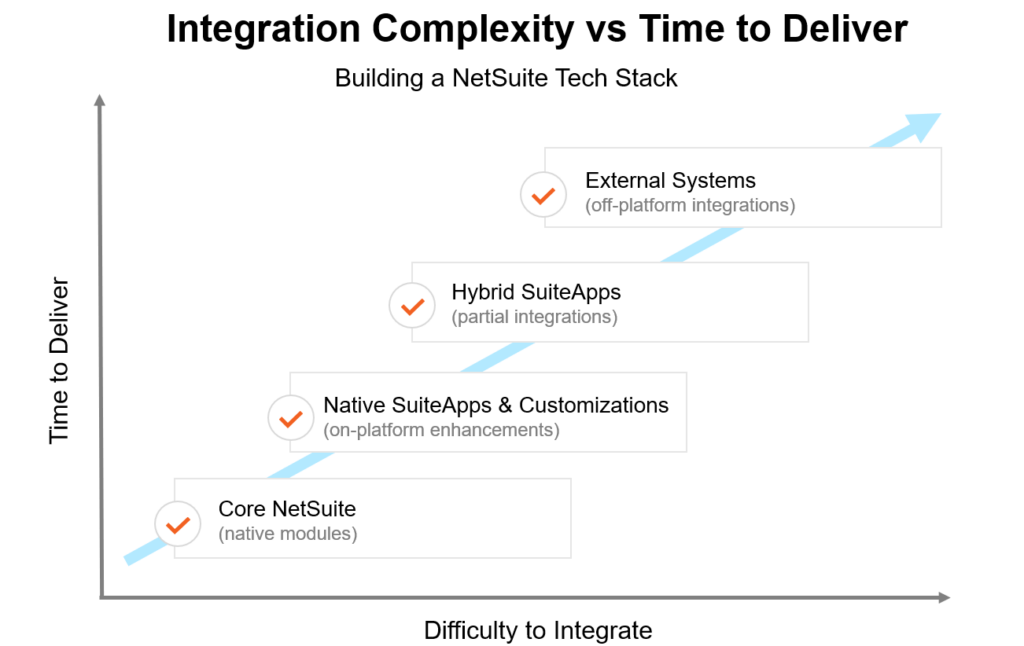As a cloud-based ERP solution, NetSuite enables businesses to streamline operations, scale intelligently, and, perhaps most importantly to today’s finance and IT leaders, integrate seamlessly with other systems. It serves as a central hub for digital transformation and a single source of truth for key operational and financial information that drives corporate decision-making and competitive advantage.
So how can organizations maximize NetSuite’s value and role within their enterprise technology architecture?
Making Enterprise Connections With NetSuite
By enabling seamless data flow across departments and systems, NetSuite builds a strong technology backbone for your organization. This foundation creates and generates:
- A unified system of record: NetSuite consolidates data from multiple business functions (financials, CRM, HR, and more) to offer integrated visibility and control.
- Scalability: NetSuite grows with the business’s needs at any stage of its lifecycle and maturity.
- Integration with SuiteApps and external systems: With over 500+ SuiteApps, NetSuite supports functionality across AP automation, supply chain, and analytics. Even better, integrations with external platforms like Salesforce and Coupa make it a flexible choice for modern enterprises.

Want to estimate the cost of licensing, implementing, and configuring NetSuite for your business? Access our custom pricing calculator.
While NetSuite helps unite enterprise systems, there are a series of other technology investments and capabilities that companies must have in their tech stack, as explored below:
Key Components of a Modern Tech Stack
To create a robust, value-driven tech stack, businesses must focus on tools that drive results across critical areas. CIOs should prioritize:
1. Customer Relationship Management (CRM)
Integrating CRMs like Salesforce or HubSpot with NetSuite enhances customer insights. Real-time synchronization ensures your teams have access to the latest customer activities, boosting sales and customer retention.
Real-world example: See how CrossCountry Consulting created a custom CRM solution that provided central storage of all key company information and automation of critical processes for an insurance provider.
2. Analytics and Reporting
Harness the power of NetSuite Analytics Warehouse to uncover actionable insights. Advanced reporting dashboards and tools like Oracle Analytics Cloud can help transform raw data into meaningful decisions.
3. E-commerce Integration
For businesses with digital storefronts, seamless integration with platforms like Shopify and Magento ensures smooth order processing, inventory tracking, and improved customer experiences.
Learn more: An apparel brand achieved +50% increase in efficiency across its distribution center thanks to a custom-designed NetSuite solution.
4. Supply Chain and Procurement Automation
NetSuite’s suite of tools, such as the Intelligent Supply Chain Control Tower and supply chain management module, enables precise demand forecasting and real-time inventory adjustments, reducing inefficiencies. And with a strategic integration with Coupa, NetSuite users can seamlessly connect and optimize procurement processes to enhance accuracy, streamline operations, and strengthen control and compliance.
Featured Insight
5. Human Resources Management Systems (HRMS)
HR teams can use NetSuite integrations with Workday or BambooHR to optimize hiring, onboarding, and employee engagement efforts.
By carefully selecting components that align with your organization’s objectives, you can design a tech stack that drives value and supports agile operations.
Building Your Tech Stack with NetSuite
Here’s the step-by-step process for building a modern tech stack with NetSuite at its core:
Step 1. Assess Current Infrastructure
Analyze your existing technology ecosystem. Are your tools siloed? Are there gaps in data accessibility, insights, or functionality? Conduct an IT audit to determine what needs integration or replacement.
Step 2. Define Your Needs and Goals
Link your tech stack strategy to business objectives. Whether it’s growth, cost reduction, or efficiency gains, clarity on your goals will guide your roadmap.
Step 3. Centralize Operations with NetSuite
Use NetSuite as your foundation. Configure its native features like financial management, CRM, and ERP functions to establish a centralized operational framework.
End-to-end NetSuite value creation with an expert implementation and advisory partner
Streamline operations, improve financial visibility, build customer relationships, and more with full-lifecycle certified NetSuite solutions.
Step 4. Integrate Complementary Tools
Identify technologies that will complement NetSuite. For instance, plug in analytics platforms for decision-making or sync with e-commerce solutions for better order fulfillment.
Step 5. Leverage SuiteApps
Explore 500+ SuiteApps to extend the functionality of NetSuite. Tools like Netgain for accounting or Avalara for tax compliance are great places to start.
Step 6. Test and Optimize
Before full deployment, test your new tech stack in a sandbox environment. Ensure seamless integration, proper function of automated workflows, and reliable data accuracy.
Step 7. Ongoing Monitoring and Scalability
The tech landscape evolves fast. Set up monitoring dashboards and allocate resources for regular stack optimization to future-proof your system.
Buy vs Build: Making the Right Choice
Organizations often wrestle with the “Build vs. Buy” dilemma when designing their tech stack.
Buy when stability is key, such as backend ERP implementations, but build custom solutions for front-end systems to tailor the experience to your customer. This hybrid approach ensures both innovation and operational reliability.
NetSuite offers a balanced framework to buy vs build, allowing businesses to build on the frontend for tailored customer experiences while buying on the backend for stable processes and compliance.
When to Buy
- The solution fits 80%+ of requirements and can be adapted for a 100% fit.
- Direct impact on accounting or financials increases risk for DIY builds.
- Vendor support is readily available for business-critical processes.
- In-house resources are insufficient or have a risk of turnover.
Featured Insight
When to Build
- Internal or consulting team deeply understands requirements.
- Stable internal or consulting resources to support solution and optimizations.
- Time and energy are present to focus on solution architecture and testing.
- “Buy” vendor poses a risk of not supporting the tool in the near future due to size/scale.
If building, consider the following checklist to ensure the internal resources and capacity exist to successfully execute:
- Clear requirements?
- Clear design options?
- Accurate effort estimation?
- Ability to roll out and support?
- Is it needed or just wanted?
- Who does it impact?
- What problem is being solved?
- What are the benefits and risks?
- Is it simple enough?
- Is there really ROI on building something?
- Does it meet all requirements?
- Does it create other problems?
- Is the team qualified to build?
- Do they understand the design?
- Is the effort and timeline estimated properly?
- Is the cost fixed or variable?
- Is change management required?
- Are process changes needed?
- Is training required?
- Who will support after launch?
Leveraging a proprietary implementation support framework, CrossCountry Consulting’s integrated teams bring comprehensive solutions to every systems project and assist with vendor analysis, system selection, stakeholder alignment, transformation roadmaps, business as usual (BAU) support, controls design and testing, talent upskilling, system enhancements, continuous process improvements, and more.
Future-Proofing NetSuite
NetSuite is increasingly integrating AI to enhance its capabilities. AI tools can identify trends, make predictions, offer recommendations, and handle repetitive tasks, thereby increasing accuracy, speed, and employee productivity while reducing errors. Key AI services in NetSuite include anomaly detection, vision, speech forecasting, language and document understanding, and generative AI services.
As AI continues to evolve, so must your NetSuite environment and holistic enterprise architecture. A scalable, flexible tech stack adapts to changing business needs while empowering intelligent decision-making now and in the future.
Are you ready to transform your tech stack? Contact CrossCountry Consulting for expert NetSuite implementation and optimization.

